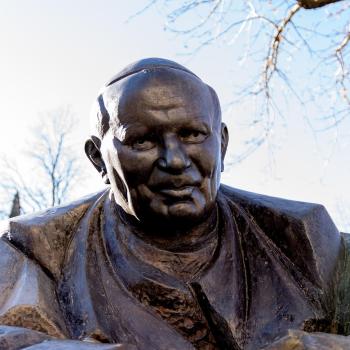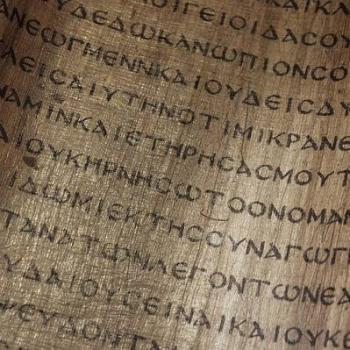LIBBY ASKS:
If human origins began with one couple, Adam and Eve, how did Cain find a wife?
THE RELIGION GUY ANSWERS:
The famous biblical story of Cain, history’s first murderer, includes this old Bible head-scratcher about who his wife could have been. Genesis 4 tells of Cain’s birth, agricultural vocation, rivalry and killing of his younger brother Abel. God curses Cain to wanderings and hard toil in the fields, yet mercifully grants a mysterious “mark” for protection against those who might want to kill him. Cain enters exile “in the land of Nod, east of Eden.” Only then do we learn that Cain is married (verse 17). John Calvin’s classic commentary from 1554 thought the context indicates Cain married in Eden, though others say a wife from Nod is possible.
In the strictly literal reading, after Abel died there would have been only three true human beings, Adam, Eve, and Cain. So, skeptics demand, who was the wife? At the 1925 “Scopes Trial,” pro-evolution lawyer Clarence Darrow used the wife to ridicule his opponent William Jennings Bryan as he quizzed him about Bible details on the witness stand. (Darrow: “Did you ever discover where Cain got his wife?” Bryan: “No, sir. I leave the agnostics to hunt for her.”) Similarly, scientist Carl Sagan’s novel and movie “Contact” employed Cain’s wife to undermine conservative belief in the Bible.
For modern-day liberals there’s no problem; they figure the early chapters of Genesis are pure myth. Others see some history here but question that Adam and Eve were literally humanity’s first couple. However, Jewish and Christian tradition holds that the Book of Genesis presents humanity’s actual origin with the first parents, Adam and Eve, and Cain as their first child. This sort of historical detail is especially important for evangelical and fundamentalist Protestants.
Ancient Jewish tradition explained that Cain married one of Adam and Eve’s daughters, who are mentioned in chapter 5. That’s the view of the Book of Jubilees (2nd Century B.C.E.), historian Josephus (1st Century C.E.), and the Talmud. Brandeis University exegete Nahum Sarna wrote that “in the present narrative context no other possibility exists.” One ancient midrash named her Awan while ancient rabbinical speculation thought Cain and Abel both married their sisters and Cain killed Abel out of envy and lust because Abel’s wife was more beautiful.
If Cain married his sister, that’s incest. Scandal! The customary explanation is that the Bible didn’t fully define incest alongside other sexual sins till much later, in the time of Moses (Leviticus 18, Deuteronomy 27). Incest is opposed not only for emotional reasons but to prevent genetic flaws from inbreeding, but Bible analysts figure that before the Fall the first humans in Eden would have been created with perfect genes. Kenneth Mathews of Samford University observes that as the early population expanded, “sibling marriage was unnecessary” and became subject to moral denunciation.
Conservatives face a bigger problem than Cain’s wife. We’re told Cain feared that because he committed murder “whoever finds me will slay me” (verse 14). If Adam, Eve, and Cain were the only humans in existence at that point, then what was Cain afraid of?
Ronald Youngblood of Bethel Seminary (who died July 5) said the context, including Cain building a “city” or “town” (verse 17) “seems to presuppose considerable numbers of people. It would place a severe strain on the passage to insist that all of them were additional children of Adam and Eve.” So he proposed the “possible” explanation of “hominids (Cro-Magnon, Neanderthal, and earlier)” who “may have existed prior to the time of Adam” but “had only animal intelligence and were not bound to God in a covenant relationship.”
Another evangelical, Britain’s Derek Kidner, offered a slightly different “tentative” proposal in his Intervarsity Press commentary on Genesis. He said the scriptural text allows the possibility that God employed evolution in which “a considerable stock of near-humans preceded the first true man.” Kidner suggested these predecessors could have prepared for homo sapiens through “a long history of practical intelligence, artistic sensibility, and capacity for awe and reflection.” Adam would be “the first true man” but those other beings could have had “comparable intelligence.” Then, after God created Adam perhaps he conferred the divine “image” on them “to bring them into the same realm of being.”
The great British Anglican author C.S. Lewis mused about such scenarios decades ago. But hardline “creationist” Ken Ham rejects any idea of people or semi-people apart from the line originating with Adam and Eve. “Defenders of the Gospel must be able to show that all human beings are descendants of one man and one woman (Adam and Eve) because only descendants of Adam and Eve can be saved.”












